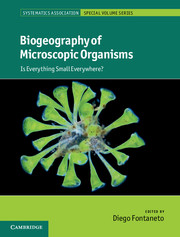Book contents
- Frontmatter
- Contents
- List of contributors
- Preface
- Part I Theoretical framework
- Part II Prokaryotes
- Part III Unicellular eukaryotes
- 5 Dispersal of protists: the role of cysts and human introductions
- 6 Everything is everywhere: a twenty-first century de-/reconstruction with respect to protists
- 7 Arcellinida testate amoebae (Amoebozoa: Arcellinida): model of organisms for assessing microbial biogeography
- 8 Everything is not everywhere: the distribution of cactophilic yeast
- Part IV Pluricellular eukaryotes
- Part V Processes
- Index
- Systematics Association Publications
- Systematics Association Special Volumes
- Plate section
- References
5 - Dispersal of protists: the role of cysts and human introductions
from Part III - Unicellular eukaryotes
Published online by Cambridge University Press: 05 August 2012
- Frontmatter
- Contents
- List of contributors
- Preface
- Part I Theoretical framework
- Part II Prokaryotes
- Part III Unicellular eukaryotes
- 5 Dispersal of protists: the role of cysts and human introductions
- 6 Everything is everywhere: a twenty-first century de-/reconstruction with respect to protists
- 7 Arcellinida testate amoebae (Amoebozoa: Arcellinida): model of organisms for assessing microbial biogeography
- 8 Everything is not everywhere: the distribution of cactophilic yeast
- Part IV Pluricellular eukaryotes
- Part V Processes
- Index
- Systematics Association Publications
- Systematics Association Special Volumes
- Plate section
- References
Summary
Introduction
While the distribution of flowering plants and larger animals is easy to determine, this is almost impossible in microorganisms, which are smaller than human beings by a factor of 1.8 × 106, assuming an average size of 100 µm and 180 cm, respectively. Thus, the subject has been searched with varied success and in heated debates (Foissner, 2004; Fenchel and Finlay, 2005), resulting in two hypotheses: the ‘cosmopolitan model’ (Finlay, 2002; Finlay et al., 2004) and the ‘moderate endemicity model’, which suggests that one-third of protists has restricted distribution (Foissner, 1999, 2006, 2008). The cosmopolitan model is based on ecological theory, while the moderate endemicity model emphasises flagship species which are so showy, or so novel, that it is unlikely that they would be overlooked if indeed they were widely distributed (Tyler, 1996). The debate has stimulated many investigations whose conclusions frequently read as follows (Bass et al., 2007): ‘Our results strongly suggest that geographic dispersal in macroorganisms and microbes is not fundamentally different: some taxa show restricted and/or patchy distributions while others are clearly cosmopolitan. These results are concordant with the ‘moderate endemicity model’ of microbial biogeography. Rare or continentally endemic microbes may be ecologically significant and potentially of conservational concern.
- Type
- Chapter
- Information
- Biogeography of Microscopic OrganismsIs Everything Small Everywhere?, pp. 61 - 87Publisher: Cambridge University PressPrint publication year: 2011
References
- 18
- Cited by

